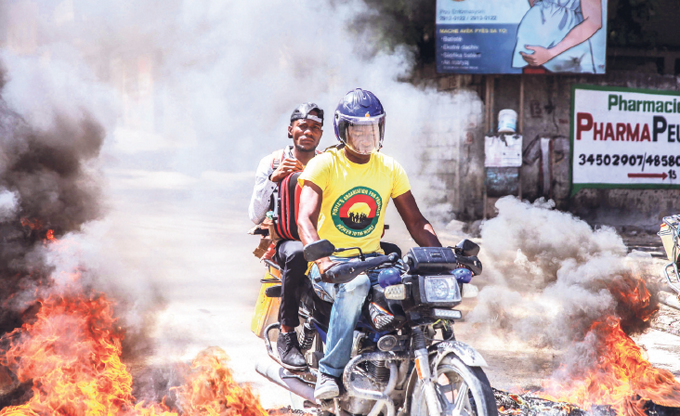Disarmament proposal in the face of collapsing Haiti

The proposal of President Abenader, President Quesada, of Costa Rica, and Cortizo, of Panama, to disarm the Haitian population is the least that can be done before a unilateral invasion by the United States of that Caribbean country occurs.
The United States uses diplomacy and peaceful means to counter the assault and kidnapping of 16 missionaries from that country and one Canadian, in exchange for extremist members of the 400 Mawozo, a gang that demands $17 million in ransom. .
The situation in Haiti appears to be deteriorating.
Prime Minister Ariel Henry announced the resignation of the Chief of Police, Leon Charles, as a result of the inability to prevent the abduction of missionaries.
In Charles’s place, the prime minister appointed the career policeman, who was the inspector general, Franz Elbe, in the midst of a general strike against insecurity, demonstrations of all kinds in the country, and the wealthy seeking to leave it.
The disarmament of the Haitian population requested by President Abenader and the leaders of Costa Rica and Panama has little to do with the kidnapping in Port-au-Prince, but rather seeks to calm the situation in Haiti, a country in crisis since the assassination of President Moss.
For Abenader, disarming the Haitian population would also have a purpose, as in the past, to prevent opponents of the Haitian regime or armed bandits from approaching or crossing the border, which might involve Dominican weapons in this case.
The document, signed by the presidents in Panama City, expresses concern about the challenges posed by the political, economic, social, food and security crisis in Haiti. They ask the international community and Haitian to help in the solution.
Presidents are turning to ECLAC and the United Nations Development Program to develop a comprehensive sustainable plan for Haiti, as well as fund a community-based river basin restoration, reforestation, and ecosystem restoration program to help create jobs.
The proposal to disarm and appease the Haitian population has found rejection among the political and legislative sectors that follow the traditional line of disarmament in the face of Haiti which is collapsing to reject all the initiatives proposed by President Abenader, on the home front or at home. the outside.
If the diplomatic action of several countries cornered them and the US and Canada threatened not to pay the $17 million ransom, the attackers could release the detainees, or risk a North American assault to save them. Hostages, who can count on the support of Haitians exhausted from crime.
Abenader takes over the work
President Abenader does not want the situation in Haiti to get any worse. The neighboring country is the main trading partner of the Dominicans, Haitian labor is the basis for construction, and therefore also from here to the Caribbean. According to the figures published by the Central Bank for the period from January to August, it closed with a cumulative growth of nearly 13%, and with its dynamism it is among the Latin American countries that will achieve the best recovery between now and the end of the period. general.
The Central Bank report notes that the current growth of the economy indicates a GDP forecast that indicates a double-digit growth rate on an annual basis, i.e. 10% more or less “which puts the Democratic Republic of the Congo within the countries that would lead the economic performance of the America region Latin”.
And as a boost to growth, he cited construction, hotels, bars, restaurants, and manufacturing free zones. The construction sector grew by 32.4% during this period. Hotels, bars and restaurants 26.6% and manufacturing free zones 26.3% to name a few.
enhanced economy
Governor Hector Valdez Albizu, in his speech on Friday during the celebration of the 74th anniversary of the founding of the Central Bank, welcomed the fact that the development of the country’s economic activity has overcome the economic effects of COVID-19, through the implementation of financial support policies and with the will, decision and effort of President Abenader.
“Indeed, I am happy to announce to the country that according to preliminary figures in January-September real GDP grew by 12.7% compared to the same period last year. This result is in line with annual changes to quarterly GDP of 3.1%, the governor said. in January-March, 25.4% in April-June, and 11.4% in July-September.
He added, “The impressive performance of the first nine months of the year reinforces expectations that the Dominican Republic will achieve double-digit expansion at the end of 2021, i.e. 10% or more, making the country once again one of the fastest growing economies in Latin America.”
“This growth does not constitute a simple statistical recovery, but an important revitalization with respect to pre-COVID-19 levels,” Valdez Albizu noted. To illustrate this point, we turn to comparing the IMAE production volume index (monthly indicator of economic activity) for September 2019, which was 173.3 with the September 2021 index, which rose to 181.0, and got 4.4% in relation to the pre-epidemic, a real achievement in light of the health shock that affected the economy.”
“In fact, if the real product accumulated in 2021 is compared with 2019, the Dominican economy grew by 3.6%, which is a remarkable achievement at a time when about a dozen countries in Latin America show negative or zero growth in relation to the period.” says the governor. .




:quality(85)/cloudfront-us-east-1.images.arcpublishing.com/infobae/P3M34YHXTVFZTCYTQQSSPRA4ZM)